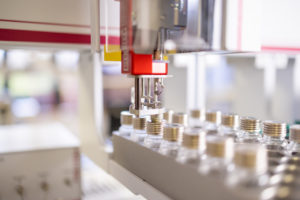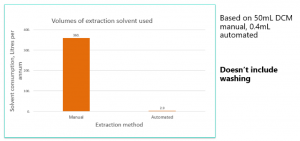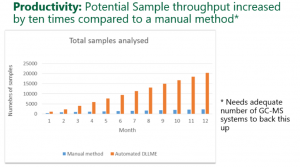Automated Sample Preparation for Water and Environmental Analysis

In this article, Anatune’s Senior Applications Chemist, Jonathan Dunscombe, explains the benefits of automated sample preparation for water and environmental analysis:
As a scientist, I enjoy sample preparation. There is something very therapeutic about preparing samples of a particular method over the course of a couple of hours. Whilst it can be physically demanding (everybody has had to shake separating funnels), and there are times when intense concentration is needed (a shoutout to anyone who has been interrupted partway through spiking internal standards), it can be a time where the mind is devoted to one task alone bringing benefits of mindfulness practice.
However, regardless of the mind calming benefits or enjoyment I get from sample preparation, there are some well-known risks attached: shaking flasks repeatedly has Repetitive Strain Injury risks, and manual spiking always runs the risk of missing samples as well as many other points of possible error, mishap or in a worst case, chemical or manual handling injury. This is where automation steps in.
The benefits of automated sample preparation are well-advertised, but is always worth revisiting them to make sure we are doing the best for our laboratory’s analytical practices. To start, let’s look at some key selling points of automated sample preparation versus manual by comparing typical methods.
Manual (liquid-liquid) vs Automated (Dispersive Liquid-Liquid MicroExtraction, DiLLME) Solvent Extraction

What can be taken from this?
Firstly, the automated method has fewer manual steps, as you would expect. Secondly, the solvent volumes are reduced considerably delivering both environmental and financial benefits.
The image below is from a webinar that I presented on automated DiLLME and shows how extraction solvent volume was drastically reduced by automation compared to a manual sample preparation method. As is noted, solvent washing of syringes or flasks is not included here but syringe washes will still use considerably less solvent than washings associated with separating funnels or zymark tubes.

Figure 1. solvent savings of automated DiLLME method compared to manual solvent extraction
Extraction time, in terms of time spent shaking, is also minimised and so the total method time is greatly reduced. As a result, sample throughput can also be enhanced to offer even greater levels of efficiency as can be seen in Figure 2 below:

Figure 2. number of samples analysed over the course of a year: automated compared to manual
Reproducibility of sample preparation can also be greatly improved via automation. Human error is removed and spiking is more consistent, as described in an earlier blog that can be found at the bottom of the page.

Figure 3. comparison of manual and automated method reproducibility
In addition to the benefits above, we have not touched upon other requirements that laboratories may have.
Perhaps a particular method utilises reagents that are particularly hazardous. In this case, automating the method will reduce the associated health and safety risk, and/or make it easier to introduce a method that uses different, safer reagents.
It could also be that a laboratory wishes to reduce overall energy consumption. For example, they make be looking to reduce the number of fume cupboards in use. In this instance, automation would help as an automated method may no longer require a dedicated fume cupboard (this does depend on the method and health and safety requirements of the laboratory involved).
It’s therefore clear that there are many benefits to automation, and automated sample preparation has something to offer every scientist. And so if you have specific issues in your laboratory that you think could be solved by an automated method then don’t hesitate to get in touch. Here at Anatune we are the experts in providing automated analytical solutions specifically tailored to your unique needs.
CONTACT US for more information about how Anatune’s automation solutions can transform analysis
References:
https://anatune.co.uk/automated-v-manual-sample-preparation-comparison/
About the Author:

Jonathan Dunscombe, Senior Applications Chemist
“Starting my career, I gained a Chemistry Degree at University of Cardiff. Taking a pause from the scientific pathway, I trained as a science teacher before taking up position as a lab technician with Severn Trent Services.
It is with this company that I stayed for six years gaining experience in multiple techniques and analyses across multiple chemistry based disciplines. I also managed a team for two years, learning what it takes to manage a team faced with high throughput and short turnaround times.
During this time I gained experience using different GERSTEL MPS equipment; notably a dual rail headspace system and dual head ITSP solution. My strengths lay within the water industry and it is this experience I bring to the Anatune team.
I joined in January 2017 as an Applications Chemist. Before this I had many dealings with the Anatune team; this is where I experienced first-hand how experienced and enthusiastic the team are. Being able to work with people spanning multiple industries is very exciting which also expands your knowledge of other disciplines.”
Previous post
Reducing Plastic Waste with Laboratory AutomationNext post
Anatune: Future Focus – SAVE THE DATE!!
